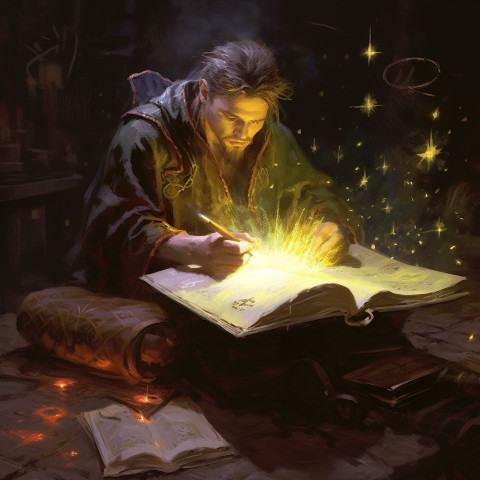As fans of Dungeons and Dragons 5th edition, we’re always excited to see what new playtest material the developers come up with. Recently, there’s been a proposed change to how wizards scribe spells into their spellbooks that has stirred up some debate in the D&D community. The change involves introducing a spell called “Scribe Spell” to handle the scribing process, a concept that harkens back to an earlier spell called “Write” from the first edition of Advanced Dungeons and Dragons. In this blog post, we’ll dive into the history of these spells, their potential purpose in the 5th edition, and whether they add value or just unnecessary complexity to the game.

A Blast from the Past: The Origins of Write and Scribe Spell
The Write spell first appeared in the earliest editions of Advanced Dungeons and Dragons. It allowed wizards to scribe spells into their spellbooks, with the interesting twist of having a chance of failure and explosion. This risk added a sense of danger and mystery to the process of acquiring new spells, making magic feel more esoteric and unpredictable.
Over time, this mechanic was streamlined, and from 3rd edition onward, scribing spells became a simple class ability for wizards. This made the process less risky and time-consuming, allowing players to focus more on adventuring and less on managing their spellbooks.
A Return to OSR Thinking with Scribe Spell?
Some might argue that the introduction of the Scribe Spell in the 5th edition playtest material is an attempt to return to the Old School Renaissance (OSR) style of play, where magic was more unpredictable and dangerous. This could be seen as a nostalgic callback to the early days of D&D, offering a more challenging and immersive experience for players who yearn for the good old days.
But Is It Necessary?
While it’s interesting to see the Scribe Spell make its debut in the playtest material as a callback to the original Write spell, its reintroduction raises the question of whether it adds meaningful depth to the game or just unnecessary complexity. It’s important for playtests to be experimental and push the boundaries of the game, but not every idea should make it into the final product.
Personally, I’m all for a spell system that adds danger or interesting management options to play, but this doesn’t do any of that. The Scribe Spell, in its current form, may be more of a designer’s pet project rather than something that will genuinely enhance the player experience. Adding a layer of complexity and potential danger to scribing spells might seem like a fun idea on paper, but in practice, it could detract from the core gameplay and frustrate players who just want to get on with their adventures.
Conclusion
The introduction of the Scribe Spell in the D&D 5th edition playtest material, as a callback to the original Write spell, is an intriguing nod to the game’s origins, but its practical value in the modern game is debatable. Personally, I don’t see what it adds to the game. While it’s great to see developers experimenting with different mechanics, it’s important to recognize when a design element might not be the best fit for the current edition. The Scribe Spell is a fascinating part of D&D history, but it may be best left in the past as we continue to evolve the game and focus on what makes it truly engaging for players.